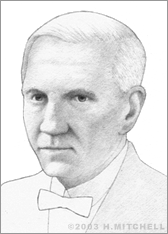Alexander Fleming
No scientific story illustrates the power of luck coupled with ingenuity quite like the tale of the discovery of penicillin. The scientist credited with the invention of this groundbreaking drug, Alexander Fleming, was born on August 6, 1881 in Ayrshire, Scotland. A bright student, Fleming worked in a shipping office for several years before returning to school to pursue a degree in medicine. He earned his MD, with honors, from St. Mary’s Medical School in London in 1908. He then worked for Almroth Wright's research team there, where he developed a strong interest in bacteriology.
Fleming became a lecturer at St. Mary’s, staying on until 1914 when he left to serve as a captain in the Army Medical Corps. During this experience, he realized that more needed to be done to save soldiers who suffered with infections from their wounds. His interest in bacteriology deepened. In 1918, he returned to St. Mary’s, where he continued to conduct research in the bacterial action of the blood, mucus, and other bodily fluids, searching for antibacterial substances that were non-toxic to animal tissues. In 1921, he discovered the bacteriolytic substance found in tears and other bodily secretions, which he named lysozyme, but this substance was not particularly strong.
In 1928, Fleming left his lab for a two-week vacation, and his failure to clean up his workspace resulted in one of the greatest medical discoveries of all time. He returned to the lab to find that a mold had accidentally developed on a staphylococcus culture plate that he had left out in the open. On the plate, a bacteria-free circle surrounded the yellow-green mold. This intrigued Fleming. He deduced that the mold must have released some substance that had inhibited the growth of the bacteria. He conducted experiments on the specimen and found that the mold culture prevented growth of staphylococci, even when diluted 800 times. The mold, he discovered, had been created by a spore of a rare variant called Penicillium notatum, which had likely drifted up from a mycology lab on another floor.
Fleming named this mold substance “penicillin” and reported his findings in 1929 in the British Journal of Experimental Pathology. However, his work would remain obscure for nearly a decade.
In 1939, a team of scientists at Oxford University, led by Australian physiologist Howard Florey, began working to identify and isolate substances from molds that could kill bacteria. Among the substances they studied was Fleming's penicillin. They were able to purify the substance and use it in experiments to treat mice who had been given lethal doses of bacteria. The experiments were overwhelmingly successful. Penicillin rapidly became a mainstream medical treatment for a variety of infections, such as syphilis, scarlet fever, diphtheria, and pneumonia. British and American drug companies began to manufacture the drug in large quantities, and by the end of World War II, it had saved millions of lives.
Fleming was elected Fellow of the Royal Society in 1943 and was knighted in 1944. Along with Florey and chemist Ernst Boris Chain, Fleming was awarded the Nobel Prize for Medicine in 1945. Fleming was named Emeritus Professor of Bacteriology at the University of London in 1948.
Over the course of his career, he authored numerous papers on bacteriology, immunology, and chemotherapy and was honored with many international awards, including honorary doctoral degrees from almost thirty European and American universities. He was Rector of Edinburgh University from 1951 to 1954.
Fleming died on March 11, 1955 and is buried in St. Paul's Cathedral in London.


